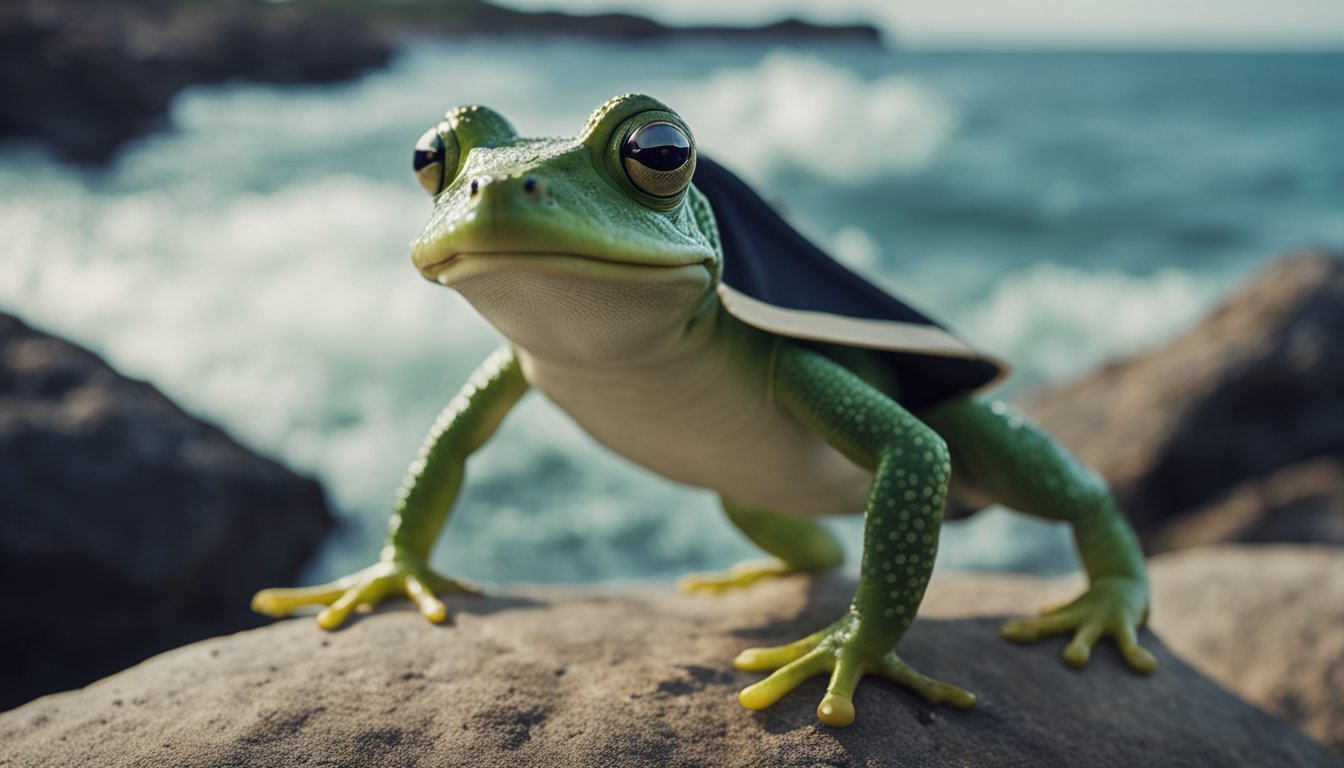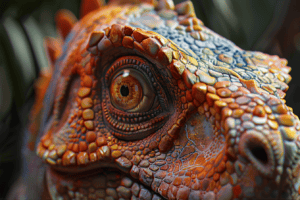Platyhystrix is an ancient amphibian that lived during the Early to Middle Permian period in what is now the United States.
What makes this creature stand out from other amphibians is the sail-like structure on its back, which is similar to those found on unrelated synapsids like Dimetrodon and Edaphosaurus.
This bizarre feature has captured the imagination of scientists and the general public alike, making Platyhystrix a fascinating creature to study.

Despite its unusual appearance, Platyhystrix was a relatively small amphibian, measuring only about one meter in length.
Fossil evidence suggests that it lived in what is now Texas, where it likely inhabited freshwater environments.
While the sail on its back is certainly its most distinctive feature, Platyhystrix was also notable for its sharp teeth and powerful jaws, which it likely used to catch prey such as fish and small reptiles.
Scientists are still trying to understand the purpose of the sail on Platyhystrix’s back.
Some theories suggest that it may have been used to regulate body temperature, while others propose that it was used for display during courtship rituals or to intimidate rivals.
Whatever its purpose, the sail is a testament to the incredible diversity of life that has existed on our planet throughout its long history.
Unraveling the Mystery of Platyhystrix

Platyhystrix is a genus of temnospondyl amphibian that lived in Texas about 300 million years ago.
It was first discovered in 1910 by Ermine Cowles Case, an American paleontologist.
Platyhystrix is known for its unique sail along its back, which was possibly used for temperature regulation.
Defining Characteristics
Platyhystrix had a frog-like face and a compact body.
Its most distinctive feature was the sail along its back, which was formed by elongated dorsal vertebrae covered in skin.
The sail could be raised or lowered to regulate the animal’s body temperature, similar to how a sailboat adjusts its sails to catch the wind.
The sail was also used for display purposes, attracting mates or intimidating rivals.
Platyhystrix had a row of small, sharp teeth, which it used to hunt small animals such as reptiles, synapsids, and other amphibians.
Its teeth were better suited for gripping small prey rather than tearing through flesh.
Historical Discovery
Platyhystrix was first discovered in 1910 by Ermine Cowles Case, an American paleontologist.
Case found a partial skull and a few vertebrae in Texas, which he named Platyhystrix rugosus.
The name Platyhystrix means “flat porcupine,” referring to the animal’s flattened body shape and the spiky appearance of its sail.
Since its discovery, several other specimens of Platyhystrix have been found in Texas and other parts of North America.
These fossils have helped paleontologists piece together a more complete picture of what Platyhystrix looked like and how it lived.
Platyhystrix remains a fascinating and mysterious animal, with many questions still unanswered about its biology and behavior.
However, its unique sail and compact body make it one of the most intriguing creatures of the ancient world.
Platyhystrix in Its Primeval World
Platyhystrix, the bizarre amphibian with a sail on its back, lived during the boundary between the latest Carboniferous and earliest Permian periods, around 300 million years ago.
This was a time when the Earth’s climate was much different than it is today.
The world was much warmer, and the continents were arranged differently, forming a single supercontinent called Pangaea.
Habitat and Lifestyle
Platyhystrix was a terrestrial amphibian that lived in a variety of habitats, including swamps, lakes, and rivers.
It was a member of the Temnospondyls, a group of amphibians that were once widespread and diverse.
These amphibians were well adapted to life on land and in water, and they ranged in size from small, lizard-like creatures to giant, crocodile-like beasts.
Platyhystrix was a large amphibian, growing up to 2 meters in length.
Its sail was made up of elongated spines that protruded from its vertebrae, and it is thought to have served several functions, including thermal regulation, display, and possibly even swimming.
Diet and Predators
Platyhystrix was a carnivorous amphibian that preyed on a variety of animals, including fish, insects, and other small amphibians.
It was also preyed upon by a variety of carnivorous reptiles, including Dimetrodon and Edaphosaurus, which were unrelated to Platyhystrix but had similar sails on their backs.
Despite its fierce appearance, Platyhystrix was not invincible.
It was vulnerable to predation, disease, and environmental changes, just like any other animal.
However, it was well adapted to its environment and was able to thrive for millions of years before eventually going extinct.
Fun fact: Did you know that Platyhystrix was not the only amphibian with a sail on its back?
Another temnospondyl amphibian called Gerrothorax also had a sail, although it was much smaller and less developed than Platyhystrix’s sail.
The Sail: Form and Function

Platyhystrix is a bizarre amphibian that stands out from other amphibians due to its unique skin-covered sail on its back.
The sail is made up of elongated dorsal vertebrae that extend upwards and are covered in skin.
The sail is similar to the sails of pelycosaurs such as Dimetrodon and Edaphosaurus.
Comparative Analysis
The sail of Platyhystrix is similar to those of Dimetrodon and Edaphosaurus, but there are some differences.
The sail of Platyhystrix is shorter and wider than those of Dimetrodon and Edaphosaurus.
Additionally, the sail of Platyhystrix is not as well-developed as those of the pelycosaurs.
Theories of Use
The function of the sail of Platyhystrix is not entirely clear.
One theory is that the sail was used for thermoregulation, allowing the animal to regulate its body temperature by absorbing or dissipating heat from the sun.
Another theory is that the sail was used for display purposes, possibly to attract mates or intimidate rivals.
While the exact function of the sail is not known, it is clear that Platyhystrix was adapting to a similar reason as the aforementioned pelycosaurs.
Indeed, their fossils and those of Platyhystrix have been found in similar environments, suggesting that they may have faced similar challenges.
Fun fact: The sail of Platyhystrix was not unique among amphibians.
Other amphibians, such as the rauisuchians, also had sails, but their function is not entirely clear.
Platyhystrix’s Legacy

Evolutionary Significance
Platyhystrix is an extinct amphibian that lived during the boundary between the latest Carboniferous and earliest Permian periods, about 300 million years ago.
It belongs to the group of animals known as Temnospondyli, which were the dominant amphibians of the early Mesozoic era.
Temnospondyls are believed to have given rise to modern amphibians and were once widespread across the globe, from the Arctic to the Antarctic.
Platyhystrix is an important species for understanding the evolution of amphibians.
It was one of the first amphibians to develop a sail on its back, a feature that is also seen in some Pelycosaurs, a group of early reptiles.
The sail was made of elongated neural spines that projected from the vertebrae.
The purpose of the sail is still debated, but it is thought to have played a role in thermoregulation, display, or as a defense mechanism.
Cultural Impact
Platyhystrix has had a limited cultural impact due to its relatively obscure status in popular culture.
However, it is an important species for paleontologists and enthusiasts of prehistoric life.
The discovery of Platyhystrix and other Temnospondyls has shed light on the early evolution of amphibians and their role in the ecosystem.
Platyhystrix is also important for understanding the classification of amphibians.
It is classified as a member of the Lissamphibians, a group that includes modern amphibians such as frogs, toads, and salamanders.
The classification of Platyhystrix and other Temnospondyls has been a subject of debate among paleontologists, but recent studies have suggested that they are more closely related to frogs and salamanders than previously thought.
In conclusion, Platyhystrix’s legacy lies in its evolutionary significance and its role in the classification of amphibians.
Although it has had a limited cultural impact, it is an important species for paleontologists and enthusiasts of prehistoric life.
Its discovery has shed light on the early evolution of amphibians and their role in the ecosystem.
Frequently Asked Questions

What kind of environment did Platyhystrix live in?
Platyhystrix lived during the boundary between the latest Carboniferous and earliest Permian periods, about 300 million years ago.
They lived in a warm and humid climate, in freshwater habitats such as swamps, ponds, and slow-moving rivers.
Platyhystrix fossils have been found in North America, specifically in Texas, Oklahoma, and New Mexico.
How did the sail on Platyhystrix’s back benefit its survival?
The sail on Platyhystrix’s back was made up of elongated neural spines that were supported by bony struts.
It is uncertain why Platyhystrix developed this sail, but some scientists believe that it may have helped regulate its body temperature, attract mates, or intimidate predators.
The sail may have also been used to store fat reserves, which would have been important during food shortages.
Can you compare Platyhystrix to any modern-day animals?
Platyhystrix is an extinct amphibian and does not have any modern-day descendants.
However, its sail has been compared to those of the unrelated synapsids, Dimetrodon and Edaphosaurus, which lived during the same time period.
These animals are often depicted in popular culture as dinosaurs, but they are actually more closely related to mammals.
What are some of the theories about the function of the sail on prehistoric creatures?
The function of the sail on prehistoric creatures is still a matter of debate among scientists.
Some believe that it was used for thermoregulation, while others think that it may have been used for display or communication.
Another theory is that the sail may have been used to store fat reserves, which would have been important during food shortages.
How do scientists determine the diet of an extinct amphibian like Platyhystrix?
Scientists can determine the diet of an extinct amphibian like Platyhystrix by studying its teeth and jaw structure.
Based on these features, scientists can make educated guesses about what the animal ate.
Platyhystrix had sharp teeth that were well-suited for catching fish and other small aquatic prey.
What other prehistoric creatures had a similar appearance to Platyhystrix?
Platyhystrix belongs to a group of amphibians known as dissorophids, which were characterized by their short, stocky bodies and large skulls.
Other dissorophids, such as Cacops and Acheloma, had similar body shapes to Platyhystrix, but did not have sails on their backs.







